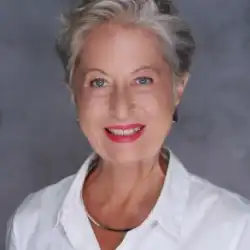Want to lead like an innovator? Mix your passions, connect the dots and fuse ideas — because real breakthroughs live between worlds.

In 2001, CIO named NetForm one of the 100 most innovative firms in the world. The social network analysis technology, methodology and mathematical models have a wide variety of applications, including HR, cybersecurity, big-data analysis, disease control and more, having launched an entire analytical industry.
Clients have included the Pentagon (security), Merrill Lynch (HR) and the LA Philharmonic (collaborative music). The tools and underlying research were popularized by Malcolm Gladwell in The New Yorker and his book “The Tipping Point.” The company and founder have been featured in The Economist, Forbes, Financial Times, Wall Street Journal, Fast Company and Wired.
But who developed it and how?
It actually began with art and quantum chemistry.
No joke.
The key to pattern recognition
Karen Stephenson loved chemistry and physics, so she decided to major in quantum chemistry. When a professor saw some of her artwork, he talked her into getting an art degree, as well.
“What kind of a job are you going to get with those degrees?” her friend asked.
“Can’t I take what I want? It is a liberal arts college.”
“Ok, fine, fine.”
One of the tests in the art program was to identify 100 artists, each based on only a portion of a painting or mere brush strokes. Karen scored 100%. She called it luck, but when she did it again for the next two consecutive years, she realized it wasn’t the art, but pattern recognition.
After college, she took post-graduate work in quantum chemistry. She was working as a chemist on the mezzanine of the lab when she noticed the people below. She saw them moving in a pattern that had little to do with their work, but which she recognized from her background in Feynman diagrams — graphical representations of the mathematics describing subatomic behavior and interactions.
She thought, “Could there be an underlying science to the way things are organized — including human beings?”
It was a eureka moment and she had to pursue it.
She changed her graduate degree to anthropology and started mapping tribal and trade networks while developing new algorithms. She tapped into anthropology, ethnology, mathematics, software development and management to find out why people were connected in these particular patterns — what was the logic behind it?
While earning her PhD at Harvard’s anthropology department, Stephenson and world-renowned statistician Marvin Zelen published a seminal article on the origin of these patterns and how they could help in understanding the epidemiology of disease. She subsequently joined UCLA’s management school faculty, founded NetForm consultancy and furthered her work in three ways: she refined her survey methodology for collecting data, created the analytic software to analyze the data and made it accessible on the internet as software for a service.
Clearly communicating the what and the why
Not all faculty applauded her non-academic efforts. In fact, a famous finance professor told her this social network fad would never amount to much.
Why was something so intriguing, with so much potential, so non-obvious to everyone else?
Back then, big data was not a big deal and cybersecurity hadn’t become what it is today. Large organizations weren’t as concerned about their social systems and didn’t have to manage major workforces that extended beyond their organizational borders.
Whenever you do something new, no one else “gets it.”
Otherwise, they would have done it.
So, communicating what you’re doing and why it’s important is crucial if you’re to gain any support. Stephenson worked with world-renowned faculty for over a year before the penny dropped for one of them and he said, “Oh, my God! I finally understand what you’ve been trying to tell me! We can do this.”
NetForm grew and Stephenson became one of the world’s foremost corporate anthropologists, later joining the faculty of Harvard’s Graduate School of Design and then the Rotterdam School of Management. Her work and methods continue to grow to this day and are captured in her published papers and books.
The heart of the matter
Patterns and puzzles persist and corporations are still hungry for the analysis and answers that few can provide.
So, what is the leadership skill?
Mental diversity and fusion.
Organizations pursue workforce diversity, but what about the mental diversity of their leaders and innovators?
Co-creation is a hot buzzword encouraging individuals to integrate and create with each other, but the simplest way to integrate and create is in the mind of one person — if they’re willing to push forward and do it. Even further, what can an integrated team of diverse minds accomplish when they co-create?
Diversity — whether in a workforce or one mind — isn’t the end. Seemingly disparate ideas and approaches — like quantum chemistry and art pattern recognition — don’t create big value on their own. They have to fuse.
In nuclear fusion, two nuclei combine to form a new one, releasing a great deal of energy into the world. Likewise, two ideas, technologies, fields, organizational silos, industries and more can combine to form something that releases a great deal of value into the world. Examples abound in business, science and technology and the arts and humanities, earning billions of dollars and saving millions of lives.
It starts with a mind that’s open outward to ideas and experiences from everywhere, as well as open inward to your own talents, interests and passions. Stephenson learned, earned degrees and continuously researched based on her own talents, interests and passions, and she was open to exploring and trying new things, e.g., even an art degree paired with quantum chemistry.
A mind that’s open is ready to collect ideas, skills and people, forming a unique workshop from which to view the world, as Stephenson’s was. Her workshop was stacked with Feynman diagrams, finely-honed pattern-recognition skills and people she then reached out to for the next step in her journey.
That sets the stage to see what others don’t and to take action, as Karen did when she saw people working in a pattern from the mezzanine. She puzzled over it night and day and ultimately went back to school in a different discipline (anthropology) to research it. She continually sees what others don’t and shares plainly what she sees. It’s important to value that gift if you have it.
Fusing can happen when openness, collecting and sensing have set the stage and Stephenson is a brilliant example of it, building research-based advances and an innovative company, tapping on an incredible variety of fields — and pioneering a new industry.
What does this mean for the rest of us?
In the age of AI, humans will need to focus on what humans do well. At the moment, at least, that’s making novel connections, thinking by analogy and creating the new. Our single-field approach to learning, qualifications and career ladders makes it hard for us to compete with machines that are often smarter than we are in any given discipline.
For that creative spark and to excel at what messy, forgetful, slow, imperfect humans do best, we need to work, think and live differently.
In fact, the founders of five of the largest companies in the world are (or were) polymaths — mentally diverse people skilled in multiple disciplines — Bill Gates, Steve Jobs, Warren Buffett, Larry Page and Jeff Bezos. They learn because they’re curious and want to solve problems, not for a career ladder.
It’s easier than ever, today, to learn with AI and online materials and to collaborate with tech and humans around the world. All you need to do is open inward to your talents and desires, explore, collect and fuse. Once you have an idea, you can reach out for the additional knowledge, skills and connections you need and co-create with both tech and humans. (You can even reach out within your own team and company.)
CIO awarded Netform in 2001. It’s taken a while to share the backstory, but it’s now more relevant than ever before.
As we live our own backstories and (hopefully) watch each other’s, remember to envision beyond borders — whether they’re field, silo, company, industry, nation or something else.
Taking your ideas where they don’t “belong” or borrowing ideas into your situation from outside is where ideas are most valuable.
And even in our short-term-leaning business environment, sticking to an idea or problem for decades can mean you’re on an innovation journey that others can’t replicate.
Maybe your new ideas, tech and new firm will be the next Top 100.
“The most innovative solutions to problems have come from the cross-pollination of fields.” —Neil deGrasse Tyson, astrophysicist
This article is published as part of the Foundry Expert Contributor Network.
Want to join?










